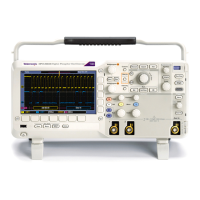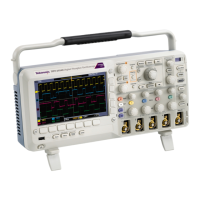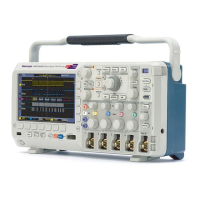Commands Listed in Alphabetical Order
Table 2-37: FPAnel:PRESS arguments (cont.)
Argument Description
BMENU5
Screen bottom menu button
BMENU6
Screen bottom menu button
BMENU7
Screen right-most bottom menu button
RMENU1
Screen top-most side menu button
RMENU2
Screen side menu button
RMENU3
Screen side menu button
RMENU4
Screen side menu button
RMENU5
Screen bottom-most side menu button
MAGnify Magnify (zoom) button (not the zoom/pan
knob)
FITERVu (2000/B series only) FilterVu frequency button
WFMOnly (2000/B series only) Waveform data button
Examples
FPANEL:PRESS AUTO SET executes the oscilloscope Autoset function.
FPAnel:TURN (No Query Form)
Simulates the action of turning a specified front-panel control knob.
When the front panel is locked, the front-panel button and multipurpose knob
operations are suspended. The FPAnel:PRESS and
FPAnel:TURN commands
will also not work, and, they will not generate an error. You can work around
this by using the appropriate programmatic interface commands, instead of the
front-panel commands. For example, to set the trigger level to 50%, you could
use TRIGger:A SETLevel. To force a trigger, you could use TRIGger FORCe.
Group
Miscellaneous
Syntax
FPAnel:TURN <knob>,[<n>]
Arguments
<knob> is the name of a rotating control.
A comma (,) separates the control knob argum
ent from the numeric optional
rotation value argument. In the absence of the numeric rotation value argument,
the default is 1 (cloc kwise). You do not need a white space between the arguments
and the comma.
<n> represents the rotation direction and magnitude of rotation. Negative values
represent a counterclockwise knob rotat
ion, and positive values represent a
MSO2000B, DPO2000B, MSO2000 and DPO2000 Series Oscilloscopes Programmer Manual 2-163

